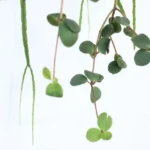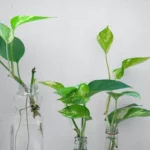Table of Contents
Facts Abouts Monstera Leaves
The Monstera is a tropical plant known for its height and perforated leaves. Monstera leaves not only have holes, but they are also split into numerous parts. Because of their size, Monsteras are usually found outside.
However, with the right amount of space, they can also be grown indoors. Here, a caregiver may have a view of the lovely Monstera leaves all the time.
There is another option for people who don’t have the space for the whole plant. It is possible to cut Monstera leaves and place them in a vase with water for decor. These leaves make lovely ornamental pieces.
To make the most of having the Monstera leaves, or the entire plant, in the home, it is crucial to know more about them.
How long does a Monstera leaf last?
Freshly cut Monstera leaves, also called Swiss Cheese leaves, typically last between one and three weeks. This longevity is because the leather-like leaves evaporate the water at slow rates.
Two or three Monstera leaves can be placed together in the same vase or similar container and survive together for this time.
Why do Monstera leaves have holes?
Each leaf may contain up to a dozen perforations. The holes in Monstera leaves appear for biological reasons. Each leaf can grow to be very large.
The holes develop to save the leaf energy and nutrients, allowing it to spread out even further while still thriving.
Can I grow Monstera from a leaf?
Monstera plants are not typically grown from the leaves. These plants are more often grown from stem cuttings. The stem can be cut just after the leaf node, removing the bottom leaves before planting it.
Stem cuttings can develop roots by being placed in water or straight into the soil. When water is chosen, it should remain there for a few weeks before being transferred to a pot.
Monstera cuttings do not require rooting hormone to grow roots because it does this so easily already.
When potting the cuttings, there are some basic requirements to encourage healthy plant development.
- Place cuttings in well-draining potting mix in a suitable pot.
- Place the pot in medium to bright indirect sunlight.
- Water the plant every one or two weeks. Soil should be dry before water is added. Filtered room temperature water is recommended.
- Mist the air around the plant once a week.
- Fertilize two to three times during the growing season. Do not fertilize during the winter.
- Monsteras perform better in temperatures between 18-30 degrees Celsius (65-85 degrees Fahrenheit). They must not be placed in temperatures below 15 degrees Celsius (60 degrees Fahrenheit).
- Apply neem oil spray weekly to prevent and treat any pest issues. Regular leaf and stem wiping is suggested.
Should you spray Monstera leaves?
Monstera leaves can survive very well in most environments. However, they do enjoy some extra mist.
The leaves can be sprayed with a fine mist, in the morning, once a week. When the misting is done early in the day, it has time to evaporate before nightfall.
Why are my Monstera leaves not splitting?
These plants require sunlight to develop and grow correctly. If the Monstera leaves aren’t splitting, it is likely they are not receiving enough light. To correct this, place the plant in a brighter area where the leaves are exposed to more light.
While it is vital for Monstera leaves to receive light to split, they should not be placed in direct sunlight. This type of light could burn the leaves.
A place exposed to bright but filtered, indirect light is recommended. Also, the plant should be rotated so that the Monstera leaves obtain equal amounts of light.
How often do Monstera plants grow new leaves?
These plants grow a new leaf approximately once a month for each growth point. Plants that have more growth points will develop more new Monstera leaves each month.
Should I cut off damaged Monstera leaves?
Cutting off damaged leaves does not impact the plant. This action will not encourage the stem to grow or additional leaves to form. A caregiver may remove damaged Monstera leaves if they wish to enhance the appearance of the plant.
However, if the appearance is not bothering the caregiver or the damage is not impacting the looks, the Monstera leaves should be left alone.
How do I make Monstera grow new leaves?
For this plant to grow new leaves, it has to grow upward. As it gets taller, additional leaf growth points will develop, allowing it to produce more Monstera leaves. This can be achieved with the right growing conditions.
To encourage faster growth, liquid fertilizer may be added. It is essential to use the right plant food as the wrong kind could damage the plant. A gentle liquid fertilizer, high in nitrogen, is usually better for this foliage. Depending on the plant food, it may need to be diluted.
There are also fertilizers developed for Monstera plants based on the exact nutrients needed for them to develop properly. If these are available, it is recommended to choose this type.
Fertilizer may be added two or three times during the growing season. If a liquid fertilizer is added, this should replace that watering cycle. The plant will not require the additional moisture.
How do you make Monstera leaves shiny?
Monstera leaves can be made shiny using a few methods. There are homemade methods and those that use commercial products.
Any of the below solutions can be applied with a soft cloth. In the case of the last option, the peel can be rubbed directly on the Monstera leaves.
- Commercial waxes for Monstera leaves and other similar plants
- Half-strength milk (diluted with water)
- Mild soap and water (mixed together)
- Banana peels
Any type of method that is utilized should be applied to the top and bottom of the Monstera leaves. If a suitable cloth isn’t available, the solutions may be applied by hand.
While shining the leaves is often done for aesthetic appeal, it is a perfect way to check for pests and disease. Also, the homemade solutions for shining Monstera leaves could be used to treat possible pest issues.


